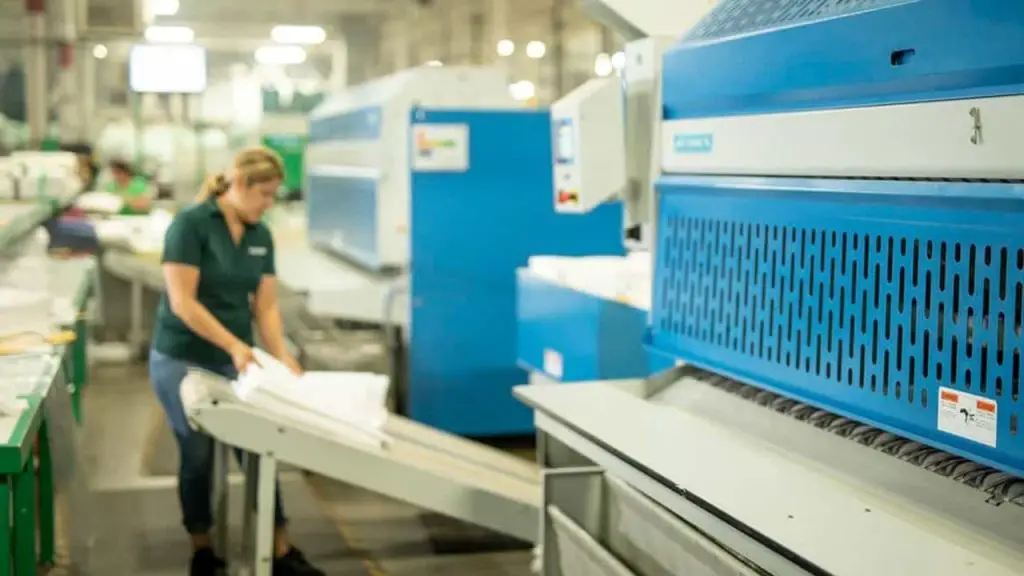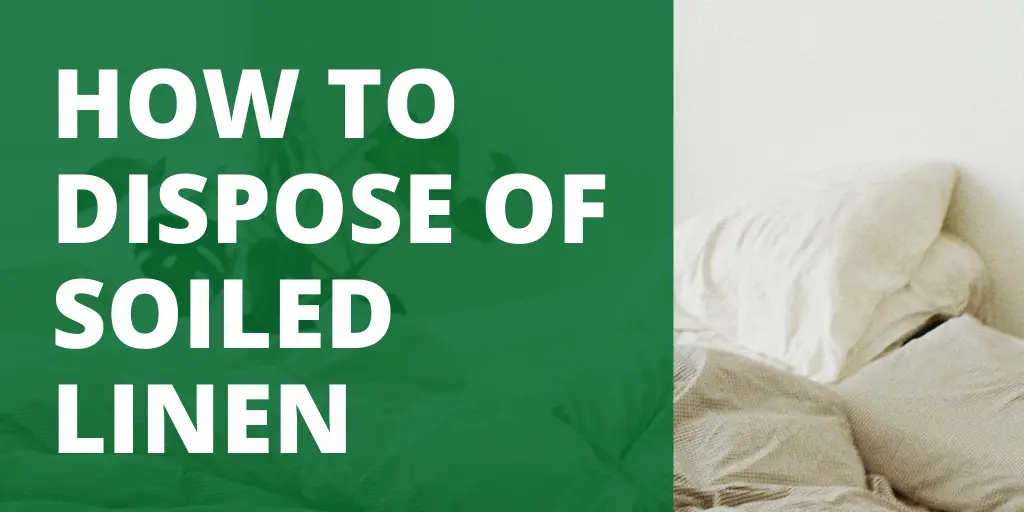If you’re in the middle of “spring cleaning” your home, you may have run into some unpleasant things. Namely dirty items that have been stuffed in a closet or room that you’ve forgotten about.
Soiled linen is a common waste item that we’ve all run into. Whether it’s old linen that’s been sitting in your closet for ages, dirty linen from wear and tear, or soiled linen, it’s best to dispose of these items as soon as you can.
Here are some tips on how to dispose of soiled linen in your home, or if you’re caring for someone who may have soiled linen.
Dispose of Soiled Linen: Step-By-Step Approach

Step 1: Identify the Type of Soiled Linen
The first step in disposing of soiled linen is to identify the type of linen you are dealing with. Soiled linen can be classified as either infectious or non-infectious. Infectious linen includes any linen contaminated with bodily fluids or other potentially infectious materials, such as blood, urine, feces, or vomit.
Non-infectious linen includes any linen soiled with food, drink dirt, or other non-infectious substances.
Step 2: Collect and Transport Soiled Linen
Once you have identified the type of linen you are dealing with, it’s time to collect and transport it to the appropriate disposal facility.
Place the soiled linen in a designated container or bag, making sure to avoid contact with your skin or clothing. Use gloves, gowns, and other personal protective equipment (PPE) if necessary.
Transport the soiled linen to the appropriate facility using a closed, leak-proof container or bag. Label the container or bag clearly with the type of linen it contains and any other relevant information, such as the date and time of collection.
Step 3: Dispose of Infectious Linen
If you are dealing with infectious linen, it must be disposed of according to strict guidelines to prevent the spread of infection. Infectious linen should be transported to a facility equipped to handle it safely, such as a medical waste treatment facility.
Follow all local, state, and federal regulations regarding the handling and disposal of infectious linen.
Step 4: Dispose of Non-infectious Linen
Non-infectious linen can be disposed of in various ways, depending on the type and local regulations. Some options include:
- Laundering: Many types of non-infectious linen can be laundered and reused. Follow the manufacturer’s instructions for laundering to ensure that the linen is adequately cleaned and sanitized.
- Recycling: Some types of non-infectious linen, such as towels and napkins, can be recycled. Check with your local recycling center to see if they accept these items.
- Landfill: If neither laundering nor recycling is an option, non-infectious linen can be disposed of in a landfill. Make sure to follow all local regulations regarding the disposal of non-infectious waste.
Step 5: Clean and Disinfect the Area
After disposing of the soiled linen, it’s essential to clean and disinfect the area where it was collected and transported. Use a disinfectant cleaner to wipe down surfaces that may have come into contact with the soiled linen, such as floors, counters, and equipment.
The procedure that UC Santa Cruz’s Student Health Center follows when disposing of soiled linen:
- “Hand hygiene protocol is followed by all personnel when handling linen.
- Standard precautions will be followed when handling soiled linen.
- Clean linen and soiled linen should be handled, stored, and transported separately.
- Linen should be maintained in good repair.
- Laundry service is provided by vendor meeting requirements for medical linen processing.”
Advantages of Disposing of Soiled Linen
Disposing of soiled linen, such as used towels, sheets, and clothing, can offer several advantages, including:
- Hygiene: Disposing of soiled linen can help prevent the spreading of infections and diseases. Soiled linen can harbor bacteria and viruses, and disposing of it properly can reduce the risk of cross-contamination.
- Space: Disposing of soiled linen can free up space in the storage area for fresh and clean linen. This can improve the efficiency of linen management, making it easier to find and distribute pure linen to suitable locations.
- Appearance: Removing soiled linen can improve the appearance of the facility. Dirty linen can be unsightly and give the impression of an unclean environment. Removing it can enhance the overall aesthetic of the facility.
- Staff safety: Disposing of soiled linen can reduce the risk of injury to staff. Dirty linen can be cumbersome to move, and improper handling can lead to damage. Proper disposal can reduce the risk of staff injury.
- Environmental health: Properly disposing of soiled linen can help protect the environment. Soiled linen can contain contaminants that can harm the environment if not disposed of properly. Proper disposal can prevent contamination of soil and water sources.
What Bacteria Can Live on Soiled Linen?
Depending on what you’re dealing with, tons of different bacteria can live on soiled linen. Even something that’s relatively clean like your bedsheets will naturally have bacteria living on the surface. However, on soiled linen, these bacteria can be dangerous to your health.
If the linen came into contact with someone who is sick, their virus or bacteria can live on the linen for days and won’t go away in that time unless it’s washed with hot water and sanitized.
Infection Control Today points out which bacteria live on soiled linens:
“Healthcare linens are known to harbor a number of microorganisms. Most notably, there is an increased concern that methicillin-resistant Staphyloccus aureus (MRSA) and vancomycin-resistant Enterococcus (VRE) can survive for days on linens.
There is further concern that these contaminated linens then become a potential source of cross-contamination.
Social Care Workers, Follow the Right Protocol
If you’re a social care worker, long-term care worker, or someone else who may handle soiled linen every day, disposing of it properly means taking care of your health and safety.
Make sure when you’re disposing of any linen that you’re wearing the right personal protective equipment (PPE) to avoid contaminating yourself.
When you’re throwing out soiled linen, make sure you’re following your workplace’s protocol. Familiarize yourself with your health and safety training, use PPE, and you will be protecting the health of yourself and everyone you come into contact with.
If you’re a social care worker or taking care of someone who is sick, Active Social Care Limited shares some advice:
“Linen that comes into contact with workers or individuals can become contaminated with harmful micro-organisms and body fluids. Linen refers to anything that is made of cloth including bedding, towels and clothing.
Personal protective equipment (PPE) must be worn when handling infected linen as it can transfer pathogens to skin and clothing. All infected linen (that is linen that is contaminated with body fluids) must be washed separately to other items.”
The Bottom Line
Proper disposal of soiled linen is critical to prevent the spread of infection and protect the health and safety of workers and the public. By following these steps, you can ensure that soiled linen is handled safely and efficiently.
Remember always to follow local, state, and federal regulations regarding the handling and disposal of soiled linen.
FAQs
How should wet, soiled linen be treated?
Wet, soiled linen should be treated promptly to prevent the growth of bacteria and mold. You should store it in a leak-proof container to avoid cross-contamination.
Finally, it should be laundered or disposed of properly to ensure hygiene and safety.
Which color of bag bin is used for disposal of soiled linen?
Soiled linen is typically disposed of in bags labeled as “infectious waste” or “biohazard waste.” The color of the bag bin used for soiled linen disposal can vary depending on the facility, but it is often red or yellow.
These colors are chosen to indicate that the bag’s contents are potentially hazardous and require special handling and disposal.
Where should soiled linen be bagged?
Soiled linen should be bagged in unique bags or containers designed for medical waste. These bags should be labeled clearly with the biohazard symbol and the word “contaminated linen” or “infectious waste.”
The bags should be securely tied and stored in a designated area until they can be properly transported for treatment and disposal.
Additional Posts:

